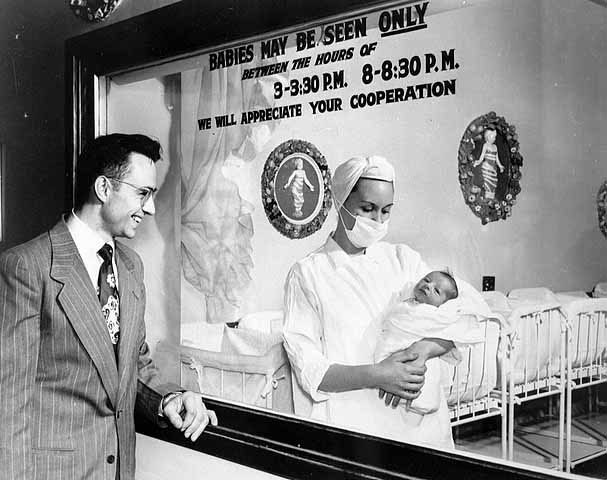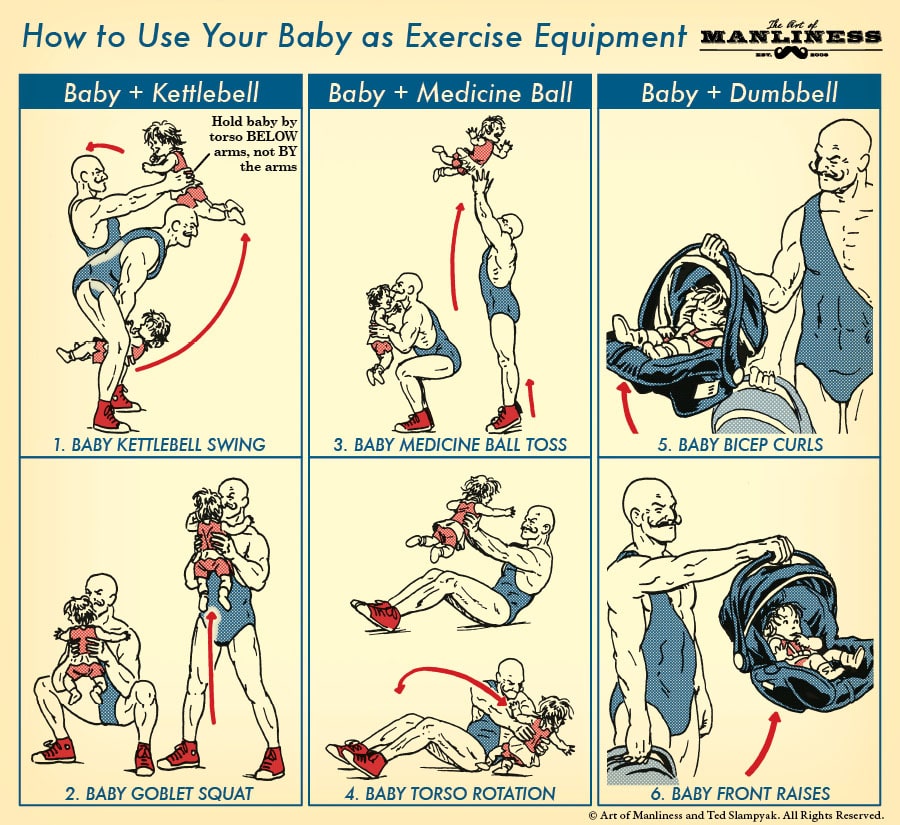
You’ve taken care of your wife during the last nine months. And you’ve made preparations for the baby’s arrival.
And now the moment has arrived at long last: it’s time to bring your progeny into the world. Are you ready?
___________
For most of human history, the delivery of a baby was an activity strictly relegated to the women’s sphere. Dad was left to pace around outside, waiting for news that his progeny had entered the world and he had officially become a father. His main duty was to hand out cigars to his friends once the nurse bounded through the lobby doors to exclaim, “It’s a boy/girl!”
These days, most couples choose to have the father of the baby right by the mother’s side throughout the whole birthing process. Some men (and some women I suppose) likely aren’t that keen on this new responsibility. For me personally, I never would have missed seeing my boy enter the world for the first time and take his first breaths. That’s an amazing moment that I’m very glad is no longer privy to only the ladies.
Just because it’s a relatively new manly role, doesn’t mean you can’t ace it. Here’s how to navigate this only-a-few-times-in-a lifetime responsibility.
Note: This post is given from my experience being the husband of a wife who chose to have an epidural and give birth in a hospital. If your wife is going the natural and/or home birth route, your experience will be different and more intense, and you should attend a childbirth class to prepare yourself.
Also, I know that the word “epidural” sends shivers down some of your non-anesthetized spines. But this post is not the place to debate birthing choices—there are a thousand mommy blogs out there where you are welcome to hash it out. Every couple should do their research and decide what’s best for them and their baby.
Before Birth: Pack a Baby Bug Out Bag
Bug Out Bags are for crisis situations like earthquakes, hurricanes… and when your wife goes into labor and needs you to take her to the hospital. When the moment comes, don’t be rushing around trying to pack a bunch of things like a headless chicken. Have your bag ready to go, so all you need to do is grab it and head out the door.
What should you pack in a Baby Bug Out Bag?
- Snacks. The labor and delivery nurse who taught our childbirth class said that while she has seen some men pass out during childbirth, it was never from the blood or birthing weirdness, but from getting faint from not eating. In all the excitement of the day, you may not feel like eating, or you may not have brought anything to eat, and don’t want to leave your wife’s side to go grab a sandwich. So bring some energy bars and others snacks to the hospital with you.
- Books/ magazines/laptop. Childbirth can take a long time, and if your wife got an epidural, she’ll be spending much of that time lying contentedly in bed and taking naps. So she won’t need your constant attention. The hospital room has a tv, and that’s about it, so bring some things to entertain yourself. Some hospitals have wi-fi these days, so you can bring your laptop and review this article!
- A sweatshirt. Hospitals keep the rooms kind of cool, so even if it’s the middle of summer, be sure to bring a sweatshirt or long-sleeved shirt.
- Camera. You’re going to want to take pictures after the birth. Still pictures. Don’t be the guy who videotapes the birth. Just don’t.
- Change of clothes/toiletries. After the birth, the hospital will keep your wife and your new baby for a day or two before sending you home (longer if there’s something wrong with mom or baby). So you need a change of clothes and at minimum a toothbrush. Consider bringing some pj’s as well. Don’t forget to pack an outfit for your new bundle of joy for when you bring him home.
During Birth: Be Her Support
Once you get to the hospital, your role becomes that of coach and support for your wife as she goes through what can be a nerve-racking process. Here are your roles.
Interference-runner. Befitting her personality, Kate took a very “eh, whatever” approach to how the birth was going to happen, but I know some moms draw up birth plans that specify their preferences pertaining to the medications they will receive, how the birth will happen, and what will happen to the baby after he’s born. If your wife has one of these birth plans, make sure the nurses and doctors are aware of it, and run interference between your wife and the people in scrubs. Don’t get in their way, but if they’re about to do something, you can ask what’s happening, and if it’s really medically necessary. If it’s not, push back and ask that they follow the birth plan. Your wife shouldn’t have to be the one who needs to stay on top of everything.
Hand-holder. If your wife gets an epidural, then birth will little resemble the sweating, panting, screaming cliché you’ve seen countless times in movies. There’s really not much for you to do. If all goes smoothly, over the course of hours she will dilate, the doctor will decide it’s time for her to push, and out will come the baby. During this time, your job is to be the rock. The calm, confident, hand-holder, who’s there with a reassuring look and word.
Be sure to be flexible and roll with the punches–because things do not always go smoothly. You may get a textbook birth where everything progresses right on schedule. Or you may get a birth where all of your best laid plans go awry. Remain levelheaded no matter what happens.
Leg-holder. When the time for pushing comes, the doctor may have you hold one of your wife’s legs up and out. Let the doctor and nurses do most of the coaching on when to push. Your job is to just be a cheerleader.
Now, at this point, you can look down and see your baby’s head coming out of your wife’s vagina. It’s a trip, man. I’ve heard that some men are grossed out by this and thus retain a repulsion long after birth to what once was a favorite area. That seems kind of weird to me—I thought the whole thing was crazy, but cool.
Cord-cutter. You will probably get the option to cut the baby’s cord and thus officially bring your baby into the world as a separate, free-wheeling human being.
After Birth: Start Things Off on the Right Foot
Don’t be alarmed at the baby’s appearance. When your baby comes out, he may be wrinkly, covered in mayonnaise-like stuff, and have a cone-head. Don’t worry—he’ll change dramatically in the next days and weeks, and start looking less like a weird, eyebrow-less Benjamin Button-like creature and more like a human baby.
Help your wife out with breastfeeding. If your wife is planning on breastfeeding, it’s best for her to give the baby his first feeding within the hour after birth. So don’t have all your friends and family rush in right after the baby is born; give your wife some time for a calm first feeding. We called our families a little while after the baby was born, let them know the news, and asked them not to come for an hour.
Despite its image as the most natural thing in the world, breastfeeding doesn’t come completely naturally (it’s about as natural as the first time you had sex). And sometimes it can be difficult—and stressful–to get it going. Call me unmanly, but before Gus was born I read a couple of books about breastfeeding, and I was very hands-on in trying to get the positioning and latching right. Kate was much appreciative.
Bathe the baby. You will likely be invited to go to the nursery to give your baby his first bath.
Have the circumcision decision already made. We’re not going to discuss the different sides of this issue–we’ve already had that debate. But by the time the baby is born, you should have done your research and made a decision. Don’t still be hemming and hawing about it at the hospital.
Help out with diaper changes. Most hospitals will let new parents keep their new baby in the room with them for most of the time. (They put Gus in this tub that sat on a cart. We called it the Gus Bucket.) It gives you a chance to hold your kid and watch in awe as she sleeps. It also means you get to change her diapers. Newborns go through a ton of diapers. In fact, they have a doctor mandated quota they’re supposed to meet to ensure they’re getting enough to eat. Your wife will probably be dog tired for a day, so roll up your sleeves and help with the diaper changing. Make sure to mark a notch for every diaper you change so you can tell the nurse. And if you and your wife need a baby break to get some sleep, you can always ask the nurses to take the baby to the nursery for a few hours.
Keep visitors at bay. If your wife isn’t in the mood to see visitors, or she is, but not a particular visitor, or if a visitor is overstaying her welcome, then your job is to kindly keep them away or show them the door. Just tell them that your wife has been through a lot and wants to rest right now. Don’t worry about hurting people’s feelings–your wife and baby are your top priority.
Make sure the information on the birth certificate is correct. A nurse will give you a sheet to fill out with information for the baby’s birth certificate. Write down everything with your best penmanship and double check that you spelled things right. You don’t want little Burt’s birth certificate to say “Butt.”
Have the car seat ready to go. Most hospitals require that you have a car seat installed before they’ll release your baby to you. I could write an entire post on car seats, but to keep things short, you’ll need a car seat designed for infants. They consist of two parts: 1) the carrier and 2) the base. Have the base properly installed in your car before you arrive at the hospital and bring the carrier to your wife’s room. Our hospital checked to see if little Gus was properly strapped in before giving us the okay to leave.
Escort your wife outside and then bring the car around. They’ll wheel mom and baby out of the hospital and to the curb. Go and get the car and pull it up to the exit. Put your newborn progeny into the car and help mom into her seat.
You’re on your own now. When you’re in the hospital, it’s still a surreal experience where doctors and nurses and friends and family are in and out. But once you’re in the car, and you shut the door–boy, it really hits you. You’ve got this baby for the rest of your life. Better start learning how to be a dad.
A Man’s Guide to Pregnancy Series:
How to Take Care of a Pregnant Wife
How to Deliver a Baby in a Pinch
Getting Ready for the Baby Bomb
Your Progeny Enters the World







